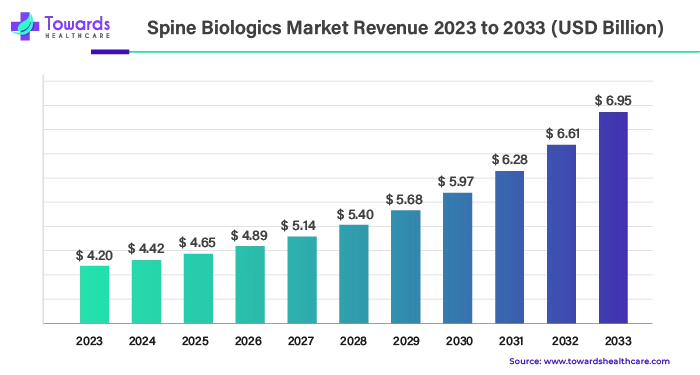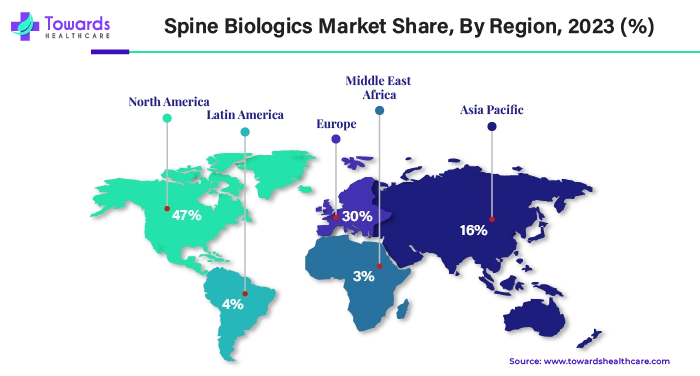April 2025

The global spine biologics market size was estimated at US$ 4.20 billion in 2023 and is projected to grow to US$ 6.95 billion by 2033, rising at a compound annual growth rate (CAGR) of 5.20% from 2024 to 2033. Key drivers of the market's expansion include the rising incidence of degenerative spine illnesses and the ensuing rise in treatment rates, developments in bone grafting techniques, and a strong demand for less invasive procedures.

In the field of orthopedic surgery, biologics represent a novel trend in medical practice. Spinal biologics are substances that actively promote growth and differentiation within their own cells, alter their external environment, and help the injured or ill person heal. They serve as a substitute for conventional medical care. A few biologics are being developed to support the regeneration and repair of cartilaginous and bony structures, while others are meant to serve as alternatives to metal devices and a person's own natural bone transplant (allograft). In the coming years, the demand for spinal biologics is anticipated to rise due to the breakthroughs in biomaterials that facilitate the treatment of patients with illnesses related to the spine by surgeons.
From 2025 to 2030, the global spine biologics market size projects to expand from USD 4.65 billion in 2025 to capture market about USD 5.97 billion by 2030, fueled by rising incidences of degenerative spine conditions, improvements in bone grafting techniques and an increasing preference for biologic solutions that offer enhanced efficacy and reduced recovery times.
| Company Name | Bone Biologics |
| Headquarters | Massachusetts, U.S., North America |
| Recent Development | In March 2024, a $2 million initial public offering was launched by Bone Biologics, a firm that specializes in spine fusion devices. A news release dated March 4 states that 781,251 shares of the company's common stock, valued at $2.56 a share, are included in the public offering. The company stated that it would use the money raised to fund working capital, general corporate objectives, its patent portfolio, and clinical studies. |
| Company Name | Biocomposites |
| Headquarters | Keele, United Kingdom, Europe |
| Recent Development | In January 2024, the U.S. Food and Drug Administration (FDA) awarded Breakthrough Device Designation to Biocomposites' investee company, Renovos Biologics (Renovos), for its lead product, RENOVITE® BMP-2 (Bone Morphogenic Protein 2). Biocomposites is a global medical devices company that designs, manufactures, and markets industry-leading products for improving bone regeneration and managing infections in bone and soft tissue. |
The increasing prevalence of spinal illnesses worldwide is driving growth in the spine biologics market. Degenerative disc degeneration and spinal fractures are illnesses that cause excruciating pain and limited movement. These conditions are exacerbated by factors like aging populations, sedentary lifestyles, and job dangers. Spine biologics, which encourage spinal fusion and tissue regeneration, provide novel therapeutic options. Examples of these include stem cell therapies and alternatives to bone grafts. Modern biotechnology has improved the safety and effectiveness of these treatments, offering better substitutes for conventional spinal fusions. The need for spine biologics is rising as patients' and healthcare providers' awareness grows, which will propel market expansion in the upcoming years.
Allografts have certain drawbacks. They are mildly osteoinductive and osteoconductive because they are also derived from human origin. However, due to the sterilizing process, allografts do not have osteogenic qualities or live cells. The low risk of HBV or HCV infection from the donor and the possibility of unfavorable alterations in the composition of the bone matrix during the radiation and chemical sterilization process are two other drawbacks of allografts.
Although spine fusion operations are becoming more and more common, it is still unknown what kind of material is best for bone regeneration. The development of safer and more effective bone regenerating scaffolds that offer solutions to these issues is made possible by the use of nanotechnology and 3D printing in the field of regenerative medicine. Using 3D printing technology, alternative methods for bone regeneration combine bioactive, biocompatible materials like hydroxyapatite with already-existing natural growth factor sources like human bone.
The spinal allografts segment held the largest share of the spine biologics market in 2023. Spinal fusion allograft bone comes from donors who are either alive or have passed away, and it is processed to maintain sterility. Allografts can be obtained easily and come in a variety of forms with advantageous handling qualities. Certain characteristics of allografts encourage bone repair and remodeling and remove the need for additional surgery and the associated problems when harvesting bone tissue, in contrast to autografts, which are made from the patient's own bone.
For instance,
The hospitals segment dominated the spine biologics market in 2023. Biologics are frequently utilized in hospitals for intricate spine procedures that call for cutting-edge care alternatives. Biologics are used in clinics for follow-up care and outpatient operations for individuals with back problems. The other market sector can consist of research facilities, specialty clinics, and ambulatory surgery centers that use biologics to treat patients' problems related to the spine and provide them with cutting-edge care.
The outpatient facilities segment is anticipated to grow at the fastest rate in the spine biologics market during 2024-2033. The healthcare system has changed to accommodate the requirements of people looking for appropriate and effective medical treatments in today's fast-paced society. With so many benefits for patients, outpatient care has become an essential part of the healthcare system. By enabling patients to receive treatment for minor injuries or illnesses without the need for hospitalization, outpatient care frees up hospital resources for more urgent situations. It also provides a reasonably priced substitute.

North America dominated the spine biologics market by 47% in 2023. A vast patient base with spinal problems, a highly established healthcare infrastructure, and the rapid adoption of breakthrough medical technologies are the reasons behind North America's market supremacy. The need for spine biologics to treat illnesses throughout the region is thus dramatically expanding because of the increasing incidence of SCI in the population. Furthermore, driving the spine biologics market in North America is encouraging reimbursement policies, robust research and development endeavors, and public knowledge of the benefits associated with minimally invasive surgical treatments. The growing prevalence of spine disorders in the U.S. is driving the spine biologics market.
For instance,
Asia Pacific is expected to grow at the fastest rate during the forecast period. Since there is a large patient population, surgeons and patients are becoming more aware of the benefits of biologics. Improved healthcare facilities and infrastructure in the area, growing healthcare expenditures, and the high incidence of spine injuries—especially those resulting from auto accidents—are the dominant factors driving the regional market. The business will probably continue to be driven by the rising prevalence of obesity as a result of sedentary lives and changing lifestyle patterns in the years to come.
Additionally, the spine biologics market in China had the most market share. One of the most prevalent public health problems that affects workability in China, the largest developing nation in the world, is low back pain (LBP). In Chinese adults, the annual prevalence of LBP is 20.88–29.88%, according to Chen et al. China's lifestyle practices, medical knowledge dissemination, and economic growth all exhibit distinctive features. Together, these variables impact the risk and prevalence of LBP in the Chinese population.
The spine biologics market in India is expanding at the quickest rate in the Asia-Pacific area. As the number of spinal injury patients in India rises alarmingly to over 200,000 each year, doctors have determined that minimal invasive surgery (MIS) is one of the best ways to treat these injuries. In contrast to conventional open surgeries, doctors claim that minimally invasive surgery (MIS) is safe and speeds up the healing process for the patient. Around 19% of adult Indians report having some form of chronic pain, with females experiencing a higher prevalence of this condition (25%). There are several factors that affect the average cost of minimally invasive spine surgery in India, which can vary from ₹3 lakh to ₹5 lakh.
By Product
By End-use
By Region
The cancer biologics market involves drugs made from living cells or their components designed to target specific molecules involved in cancer. These include vaccines, cytokines, cell-based therapies, and monoclonal antibodies. Compared to traditional treatments, these biologics are less toxic and offer personalized treatment options. The market is expected to grow because advancements in biotechnology and cancer research are creating new treatment possibilities, improving patient outcomes and quality of life. Many of these therapies are only available through clinical trials, making this area of cancer research very active.
April 2025
April 2025
April 2025
April 2025